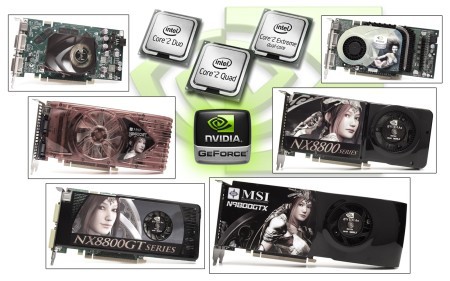Nvidia Talks DirectX Compute in Windows 7
The latest entry on the Microsoft Partner blog is from Nvidia and pushes the idea of the GPGPU. While it is written from an Nvidia product-focused, the same principals and advantages exist with GPUs from other vendors (such as your Radeon).
"With the introduction of Windows 7, the GPU and CPU will exist in a co-processing environment where each can handle the computing task they are best suited for," wrote Chris Daniel, product manager for software at Nvidia. "The CPU is exceptionally good at performing sequential calculations, I/O, and program flow, whereas the GPU is perfectly suited for performing massive parallel calculations."
Microsoft is doing its part by putting DirectX Compute in Windows 7, so that developers can make better use of the GPU for tasks other than just graphics acceleration. Having the GPU pitch in where possible will help take the load off of the CPU so that it can focus on other tasks. The ideal end result of this is that the PC should be more responsive thanks to efficient use of processing power.
Daniel gives an example of how a GPGPU could speed up a task: "With new software designed to take advantage of this capability you would be able to copy and transcode (convert a video from one format to another – a very computationally intensive task) a movie to your MTP supported portable media device up to 5 times faster when using the GPU as a co-processor with DX Compute, as compared to only doing the processing on the CPU."
Microsoft also natively supports GPU acceleration with a new Windows Media Player and Windows Media Center for H.264 video content, most of which is encoded in high-definition formats and typically more taxing on the CPU.
"Parallel programming is the next big thing for the world of computing – it has started already," said Daniel. "DirectX Compute will accelerate this discontinuity by enabling massive parallelism to the masses. What we are talking about is co-processing— essentially using the right tool for the job."
Get Tom's Hardware's best news and in-depth reviews, straight to your inbox.
-
vivekkurup ReplyWith the introduction of Windows 7, the GPU and CPU will exist in a co-processing environment where each can handle the computing task they are best suited for
...and they lived happily ever after. -
radnor Lets hope OpenCL will be "brand" agnostic. I got here 1600 Cores that love to game...and folding.Reply
Lets hope sometime cooler comes along. -
marokero Still waiting for the apps that "most of us use" (key words here) to have this facility.Reply -
mrkenan The most impressive feature of 7 I've seen yet. I hope developers take advantage of this as much as possible.Reply -
Shadow703793 mrkenanThe most impressive feature of 7 I've seen yet. I hope developers take advantage of this as much as possible.I doubt it. Most games (ie GTAIV,etc) are ported from consoles so I doubt they would take the time to optimize it to this level.Reply -
lifelesspoet I built my rig when core2 quad's got to a reasonable price and set up sli as well to future proof, thinking everything was moving to multithread. Now if general purpose software gets offloaded unto the gpu's, it would be a boost to the useful lifespan of my computer.Reply
If at the very least it would be good to know that when I'm not gaming the graphics cards are doing more then Just heading up my home -
ben850 Shadow703793I doubt it. Most games (ie GTAIV,etc) are ported from consoles so I doubt they would take the time to optimize it to this level.Reply
what i got from this article is that they're talking about applications in general, and not specifically games.
for example, if a program has fancy bells and whistles when you click a menu item, or press a button, it can draw power from the video card which would be better suited to deal with this type of processing.
of course, what i've said is very simplified but it's what i got from the article. -
nukemaster syavashwhats the difference between this and Nvida CUDA technology?One will be a standard for ALL cards(well ones that support it) not just Nvidia ones, kind of like ATI's own implementation, will be nice for everything to work on all hardware.Reply

